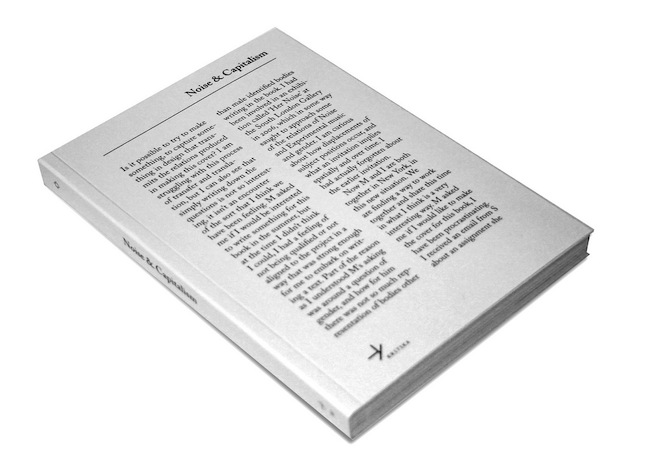Mattin, Anthony Iles (eds.): Noise & Capitalism (2009) [English, Catalan]
Filed under book | Tags: · attention economy, capitalism, music, noise, sound recording

“This book is a tool for understanding the situation we are living through, the way our practices and our subjectivities are determined by capitalism. It explores contemporary alienation in order to discover whether the practices of improvisation and noise contain or can produce emancipatory moments and how these practices point towards social relations which can extend these moments.
If the conditions in which we produce our music affects our playing then let’s try to feel through them, understand them as much as possible and, then, change these conditions.
If our senses are appropriated by capitalism and put to work in an ‘attention economy’, let’s, then, reappropriate our senses, our capacity to feel, our receptive powers; let’s start the war at the membrane!
Alienated language is noise, but noise contains possibilities that may, who knows, be more affective than discursive, more enigmatic than dogmatic.
Noise and improvisation are practices of risk, a ‘going fragile’. Yet these risks imply a social responsibility that could take us beyond ‘phoney freedom’ and into unities of differing.
We find ourselves poised between vicariously florid academic criticism, overspecialised niche markets and basements full of anti-intellectual escapists. There is, afterall, ‘a Franco, Churchill, Roosevelt, inside all of us…’ yet this book is written neither by chiefs nor generals.
Here non-appointed practitioners, who are not yet disinterested, autotheorise ways of thinking through the contemporary conditions for making difficult music and opening up to the willfully perverse satisfactions of the auricular drives.
Contributors: Ray Brassier, Emma Hedditch, Matthew Hyland, Anthony Iles, Sara Kaaman, Mattin, Nina Power, Edwin Prévost, Bruce Russell, Matthieu Saladin, Howard Slater, Csaba Toth, Ben Watson.
The distribution of this book is going to be done by trading:
If you are an artist, musician, writer or engage in any creative activity, we would very much appreciate that you send a sample of your work as a form of exchange for the book. Otherwise you can write a critical response to the book and send it to Arteleku.
If you are a distributor or a label or a publisher and you want to get copies of the book for distribution, you can send single copies of different books, zines or records in exchange and Arteleku will send you copies of the book in return.
Any material sent to Arteleku will become part of Arteleku’s library and people will have free access to this material.
Post: Arteleku, Kristobaldegi 14 (o nuevo P. Ainzieta), Loiola Auzoa, 20014 Donostia – San Sebastián (Spain).
Email: arteleku at gipuzkoa dot net
Arteleku might take some time to reply and to send the books but they will do it as soon as they can.”
Publisher Arteleku Audiolab (Kritika series), and Donostia-San Sebastián (Gipuzkoa), Sep 2009
ISBN 9788479086221
191 pages
Noise & Capitalism (English, updated on 2019-9-13)
Ruido y capitalismo (Catalan, 21 MB, added on 2019-9-13)
Jonathan Beller: The Cinematic Mode of Production. Attention Economy and the Society of the Spectacle (2006)
Filed under book | Tags: · attention, attention economy, capitalism, cinema, film, film theory, labour, marxism, spectacle

“Cinema brings the industrial revolution to the eye,” writes Jonathan Beller, “and engages spectators in increasingly dematerialized processes of social production.” In his groundbreaking critical study, cinema is the paradigmatic example of how the act of looking has been construed by capital as “productive labor.” Through an examination of cinema over the course of the twentieth century, Beller establishes on both theoretical and historical grounds the process of the emergent capitalization of perception. This process, he says, underpins the current global economy.
By exploring a set of films made since the late 1920s, Beller argues that, through cinema, capital first posits and then presupposes looking as a value-productive activity. He argues that cinema, as the first crystallization of a new order of media, is itself an abstraction of assembly-line processes, and that the contemporary image is a politico-economic interface between the body and capitalized social machinery. Where factory workers first performed sequenced physical operations on moving objects in order to produce a commodity, in the cinema, spectators perform sequenced visual operations on moving montage fragments to produce an image.
Beller develops his argument by highlighting various innovations and film texts of the past century. These innovations include concepts and practices from the revolutionary Soviet cinema, behaviorism, Taylorism, psychoanalysis, and contemporary Hollywood film. He thus develops an analysis of what amounts to the global industrialization of perception that today informs not only the specific social functions of new media, but also sustains a violent and hierarchical global society.
Publisher University Press of New England, 2006
ISBN 1584655836, 9781584655831
332 pages
review (Robert Moses Peaslee, Journal of Communication Inquiry)
PDF (no OCR; some pages missing; updated on 2012-11-4)
Download a 2003 paper (published in Culture, Theory & Critique 44(1), 2003, pp 91-106; added on 2012-10-20)

